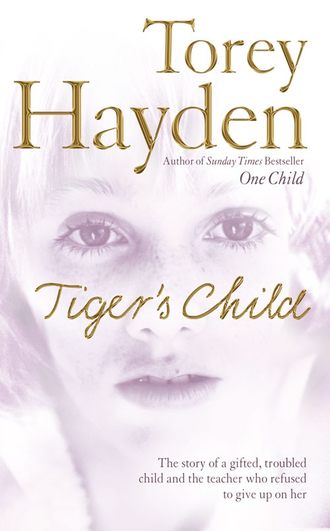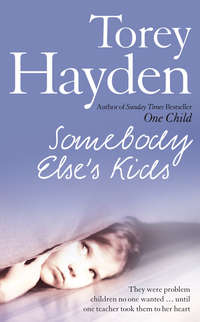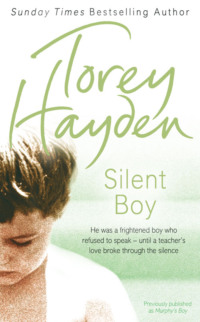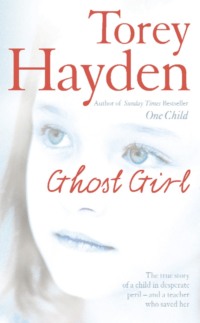
Полная версия
The Tiger’s Child: The story of a gifted, troubled child and the teacher who refused to give up on her

Torey Hayden
The Tiger’s Child

Contents
Cover
Title Page
Introduction
Prologue
Part 1
Chapter 1
Chapter 2
Chapter 3
Chapter 4
Chapter 5
Part 2
Chapter 6
Chapter 7
Chapter 8
Chapter 9
Chapter 10
Chapter 11
Chapter 12
Chapter 13
Chapter 14
Chapter 15
Chapter 16
Chapter 17
Chapter 18
Chapter 19
Chapter 20
Chapter 21
Chapter 22
Chapter 23
Chapter 24
Chapter 25
Part 3
Chapter 26
Chapter 27
Chapter 28
Chapter 29
Chapter 30
Chapter 31
Chapter 32
Epilogue
Exclusive sample chapter
Torey Hayden
About the Author
Praise for Torey Hayden and the Tiger’s Child
Other Works
Copyright
About the Publisher
Introduction
This book is based on the author’s experience as a special education teacher, but names, some identifying characteristics, dialogue, and details have been changed or reconstructed.
Prologue
It was a moment of déjà vu.
Home in Montana visiting my mother, I had nipped out alone on a Sunday morning while she and my young daughter went swimming. It was just after eleven and I was walking through the shopping mall. Most of the stores weren’t open yet, and as a consequence, the broad concourse was shadowy, illuminated only by security lighting.
Suddenly I saw her. Some distance ahead of me down the mall, she was standing in the shadows of a large planter. Long, unkempt hair tumbled down over her shoulders; bangs hung into her eyes; thick, sensual lips were pushed out in a dramatic pout. She stood with arms crossed tightly over her chest, her shoulders pulled up, her face set in an expression of fierce defiance; and yet there was a poignancy about all that fierceness. I suspect she already knew she wasn’t going to win. I was well down the mall when I first saw her, but I recognized her so instantly that adrenaline shot through my veins. Sheila.
A second or two later my intellect caught up. It wasn’t Sheila, of course. More than twenty years have passed since I watched Sheila depart from my classroom on that warm June afternoon. I am no longer the angry young teacher I was. My teaching days are, at least for the time being, behind me and I have exchanged youth—with some reluctance—for middle age. Yet, for those brief few minutes in the shopping mall, the years disappeared. I was pulled back into the seventies, into my workaholic twenties, to feel once again, however fleetingly, the person I had been and the world as it was then.
Then reality began to impose, layering itself down over the incident rather the way one lays a transparency down over a page. I approached the girl with curiosity, drew up even with her and paused, feigning interest in a nearby shop window so that I could unobtrusively study her. She was older than Sheila had been. She was perhaps seven or even eight. Her hair was darker, more mouse-brown than blond.
My nearness didn’t put off her anger any. I was a stranger, so she ignored me and concentrated all her attention on the open doorway of the huge department store behind me. I couldn’t discern who had upset her so. They had disappeared into the store, but she stood on, her small fists clenched, her tousled hair falling forward, her hopeless, helpless anger emanating from her. Anonymous and silent, I remained where I was, half a dozen feet away, and marveled at how such a small encounter could wipe away so many years, how Sheila could still set my heart beating fast.
Sheila and I, as student and teacher, were only together for five months. Our relationship over that short time evoked dramatic changes in Sheila’s behavior and vastly altered the course of her life. Although less obvious at the time, our relationship also dramatically changed me and vastly altered the course of my life too. This little girl had a profound effect on me. Her courage, her resilience and her inadvertent ability to express that great, gaping need to be loved that we all feel—in short, her humanness—brought me into contact with my own.
The five months Sheila was in my class I chronicled in One Child. It was a private book, never initially written with the intention of publication, but only as my own effort to understand more fully this deeply felt relationship. I was teaching a university graduate class in special education at the time and it is to a student in that class that I owe my thanks. The last day of class she gave me a copy of Ron Jones’s The Acorn People, and inscribed it in the front: To Torey, in hopes that someday you might write about Sheila, Leslie and all the others.
One Child now spans the world in twenty-two languages and has brought me into contact with individuals from Sweden to South Africa, from New York to Singapore. One reader wrote from a base in Antarctica; a handful of letters came from behind the Iron Curtain before it fell; and I have just recently received my first correspondence over One Child from mainland China. The universal appeal of watching Sheila grow and change has only been matched by one thing, a question: What happened next?
One Child is a true story, based on real people and real people’s experiences. I hesitated to write a sequel simply because six-year-old Sheila was so appealing and the period we spent together was so positive. Indeed, my One Child editor went so far as to suggest I not include in the epilogue of the book what had actually been happening to Sheila in the time since we had parted. Real lives are seldom as satisfying as fiction, or even as satisfying as judiciously edited nonfiction, and it was felt the interim period between my class and the time I wrote One Child would make too grim an ending for such an upbeat story. Thus, the book concluded with Sheila’s beautiful poem, but no details.
I’ve now changed my mind, not only in response to the countless queries from my readers, but also in response to Sheila, who, against remarkable odds, has grown into an engaging, articulate young woman. Those five months we spent together did have a profound effect on her, but One Child, although I hadn’t meant it to, tells my story. The experience for Sheila was quite a different one and here, to quote Paul Harvey, is the rest of the story.
Chapter 1
The article in the newspaper was tiny, considering the crime. It told of a six-year-old girl who had lured a local toddler from his yard, taken him to a nearby woodland, tied him to a tree and set fire to him. The boy, badly burned, was in hospital. All that was said in what amounted to no more than a space filler below the comic strips on page six. I read it and, repulsed, I turned the page and went on.
Six weeks later, Ed, the special education director, phoned me. It was early January, the day we were returning from our Christmas break. “There’s going to be a new girl in your class. Remember that little girl who set fire to the kid in November …?”
I taught what was affectionately referred to in our district as the “garbage class.” It was the last year before congressional law would introduce “mainstreaming,” the requirement that all special needs children be educated in the least restrictive environment; and thus, our district still had the myriad of small special education classrooms, each catering to a different disability. There were classes for physically handicapped, for mentally handicapped, for behaviorally disordered, for visually impaired … you name it, we had it. My eight were the kids left over, the ones who defied classification. All of them suffered emotional disorders, but most also had mental or physical disabilities as well. Out of the three girls and five boys in the group, three could not talk, one could but refused and another spoke only in echoes of other people’s words. Three of them were still in diapers and two more had regular accidents. As I had the full number of children allowed by state law for a class of severely handicapped children, I was given an aide at the start of the year; but mine hadn’t turned out to be one of the bright, hardworking aides already employed by the school, as I had expected. Mine was a Mexican-American migrant worker named Anton, who had been trawled from the local welfare list. He’d never graduated from high school, never even stayed north all winter before, and certainly had never changed diapers on a seven-year-old. My only other help came from Whitney, a fourteen-year-old junior high student, who gave up her study halls to volunteer in our class.
By all accounts we didn’t appear a very promising group, and in the beginning, chaos was the byword; however, as the months passed, we metamorphosed. Anton proved to be sensitive and hardworking, his dedication to the children becoming apparent within the first weeks. The kids, in return, responded well to having a man in the classroom and they built on one another’s strengths. Whitney’s youth occasionally made her more like one of the children than one of the staff, but her enthusiasm was contagious, making it easier for all of us to view events as adventures rather than the disasters they often were. The kids grew and changed, and by Christmas we had become a cohesive little group. Now Ed was sending me a six-year-old stick of dynamite.
Her name was Sheila. The next Monday she arrived, being dragged into my classroom by Ed, as my principal worriedly brought up the rear, his hands flapping behind her as if to fan her into the classroom. She was absolutely tiny, with fierce eyes, long, matted blond hair and a very bad smell. I was shocked to find she was so small. Given her notoriety, I had expected something considerably more Herculean. As it was, she couldn’t have been much bigger than the three-year-old she had abducted.
Abducted? I regarded her carefully.
Bureaucracy being what it is in school districts, Sheila’s school files didn’t arrive before she did; so when she went off to lunch on that first day, Anton and I took the opportunity to go down to the office for a quick look. The file made bleak reading, even by the standards of my class.
Our town, Marysville, was in proximity to a large mental hospital and a state penitentiary, and this, in addition to the migrants, had created a disproportionate underclass, many of whom lived in appalling poverty. The buildings in the migrant camp had been built as temporary summer housing and many were literally nothing but wood and tar paper that lacked even the most basic amenities, but they became crowded in the winter by those who could afford nothing better. It was here that Sheila lived with her father.
A drug addict with alcohol problems, her father had spent most of Sheila’s early years in and out of prison. He had no job. Currently on parole, he was attending an alcohol abuse program, but doing little else.
Sheila’s mother had been only fourteen when, as a runaway, she took up with Sheila’s father and became pregnant. Sheila was born two days before her mother’s fifteenth birthday. A second child, a son, was born nineteen months later. There wasn’t much else relating to the mother in the file, although it was not hard to read drugs, alcohol and domestic violence between the lines. Whatever, she must have finally had enough, because when Sheila was four, she left the family. From the brief notes, it appeared that she had intended to take both children with her, but Sheila was later found abandoned on an open stretch of freeway about thirty miles south of town. Sheila’s mother and her brother, Jimmie, were never heard from again.
The bulk of the file detailed Sheila’s behavior. At home the father appeared to have no control over her at all. She had been repeatedly found wandering around the migrant camp late at night. She had a history of fire setting and had been cited for criminal damage three times by the local police, quite an accomplishment for a six-year-old. At school, Sheila often refused to speak, and as a consequence, virtually nothing was contained in the file to tell me what or how much she might have learned. She had been in kindergarten and then first grade in an elementary school near the migrant camp until the incident with the little boy had occurred, but there were no assessment notes. In place of the usual test results and learning summaries was a catalog of horror stories detailing Sheila’s destructive, often violent, behavior.
At the end of the file was a brief summary of the incident with the toddler. The judge concluded that Sheila was out of parental control and would be best placed in a secure unit, where her needs could be better met. In this instance, he meant the children’s unit at the state mental hospital. Unfortunately, the unit was at capacity at the time of the hearing, and thus, Sheila would need to await an opening. A recently dated memo was appended detailing the need to provide some form of education, given her age and the law, but no one bothered to mince words. Her placement was custodial. This meant she had to be kept in school for the time being, because of the specifics of the law, but I need not feel under any obligation to teach her. With Sheila’s arrival, my room had become a holding pen.
Youth was my greatest asset at that point in my career. Still fired with idealism, I felt strongly that there were no problem kids, only a problem society. Although initially reluctant to take Sheila, it had been because my room was crowded and my resources overstretched already, not because of the child herself. Thus, once I had her, I regarded her as mine and my class was no holding pen! My belief in human integrity and the inalienable right of each and every one of my children to possess it was trenchant.
Well, almost. Before she was done, Sheila had given all my beliefs a good shaking and she started that very first day. As Anton and I were sitting in the front office that lunch hour, reading Sheila’s file, Sheila was in our classroom scooping the goldfish out of the aquarium and, one by one, poking their eyes out.
Sheila proved to be chaos dressed in outgrown overalls and a faded T-shirt. Everything she said was shrieked. Everything she touched was broken, hit, squashed or mangled. And everyone, myself included, was The Enemy. She operated in what Anton christened her “animal mode.” There was not much “child mode” present in the early days. The slightest unexpected movement she always interpreted as attack. Her eyes would go dark, her face would flush, her body would take on alert rigidity, and from that point it was a finely balanced matter as to whether she would fight, or panic and run away. When she was in her animal mode, our methods were a whole lot more akin to taming than teaching.
Yet …
Sheila was different. There was something electric about her, about her eyes, about the sharpness of her movements that superimposed itself over even her most feral moments. I couldn’t articulate what it was, but I could sense it.
I loved my children dearly, but the truth was, they were not a very bright lot. Most children with emotional difficulties use so much mental energy coping that there simply isn’t much left for learning. Additionally, other syndromes often occur in conjunction with psychological problems, either contributing to them or resulting from them. For example, two of my children suffered from fetal alcohol syndrome and another had a neurological condition that was causing a slow deterioration of his central nervous system. As a consequence, none of the children was functioning at an average level for his or her age, although undoubtedly several were of normal intelligence. Thus, it came as a surprise to me to discover during Sheila’s early days with us that she could add and subtract well, because she had managed only three months of first grade.
A bigger surprise came days later, when I discovered she could give the meanings of unusual words. One such word was “chattel.”
“Wherever did you learn a word like this?” I asked when my curiosity finally overwhelmed me.
Sheila, little and dirty and very smelly, sat hunched up on her chair across the table from me. She peered up through matted hair to regard me. “Chattel of Love,” she replied and added in her peculiar dialect, “it be the name of a book I find.”
“Book? Where? What book?”
“I don’t steal it,” she retorted defensively. “It be in the garbage can. I find it.”
“Where?”
“I do find it,” she repeated, obviously believing this was the issue I was trying to explore.
“Yes, okay,” I replied, “but where?”
“In the ladies’ toilets at the bus station. But I don’t steal it.”
I smiled. “No, I’m sure you didn’t. I’m just interested in hearing about it.”
She regarded me suspiciously.
“What did you do with the book?” I asked.
Sheila clearly couldn’t puzzle out why I wanted to know these things. “Well, I read it,” she said, her voice full of disbelief, as if I’d asked a very silly question. There was a worried edge to it, however. She still sensed it was an accusation.
“You read it? It sounds like a rather grown-up book.”
“Well, I don’t read all of it. But on the cover it say Chattel of Love and so I do be curious about it, ’cause of the picture,’ cause of what the man be doing to the lady on the cover.”
“I see,” I replied uncertainly.
She shrugged. “But I couldn’t find nothing good in it, so I throw it away again.”
With an IQ we soon discovered to be in excess of 180, Sheila was electric all right. Indeed, she was more like nuclear.
Discovering Sheila was a highly gifted child intellectually did nothing to change the facts of her grinding poverty, her abusive background or her continuing and continually outrageous behavior. Uncertain where to start when there was so much that needed improving, I began with the very smallest things, those I knew were within my power to change.
Sheila’s hygiene was appalling. She literally had only one set of clothes: a faded brown-striped T-shirt and a pair of worn denim overalls, a size too small. With these went a pair of red-and-white canvas sneakers with holes in the toes. She had underwear, but no socks. If any of these were ever washed, there was little evidence of it.
Certainly Sheila wasn’t washed. The dirt was worn in on her hands and her elbows and around her ankles, so that dark lines had formed over the skin in these areas. Worse, she was a bed wetter. The smell of stale urine permeated whatever part of the classroom Sheila occupied. When I quizzed Sheila about washing facilities, I discovered they had no running water.
This seemed the best place to start. She was so unpleasant to be near that it distracted all of us from the child herself; so I came armed with towels, soap and shampoo and began to bathe Sheila in the large sink at the back of the classroom.
I was washing her when I first noticed the scars. They were small, round and numerous, especially along her upper arms and the insides of her lower arms. The scars were old and had long since healed, but I recognized them for what they were—the marks left when a lit cigarette is pressed against the skin.
“Does your dad do things that cause these?” I asked, trying to keep my voice as casual and conversational as possible.
“My pa, he wouldn’t do that! He wouldn’t hurt me bad,” she replied, her tone prickly. “He loves me.” I realized she knew what I was asking.
I nodded and lifted her out of the water to dry her. For several moments Sheila said nothing, but then she twisted around to look me in the eye. “You know what my mama done, though?”
“No, what?”
She lifted up one leg and turned it for me to see. There, on the outer side just above the ankle, was a wide white scar about two inches long. “My mama, she push me out of the car and I fall down so’s a rock cutted up my leg right here. See?”
I bent forward and examined it.
“My pa, he loves me. He don’t go leaving me on no roads. You ain’t supposed to do that with little kids.”
“No, you’re not.”
There was a moment’s silence while I finished drying her and began to comb out her newly washed hair. Sheila grew pensive. “My mama, she don’t love me so good,” she said. Her voice was thoughtful, but calm and matter-of-fact. She could have been discussing one of the other children in the class or a piece of schoolwork or, for that matter, the weather. “My mama, she take Jimmie and go to California. Jimmie, he be my brother and he be four, ’cept he only be two when my mama, she leave.” A moment or two elapsed and Sheila examined her scar again. “In the beginning, my mama taked Jimmie and me, ’cept she got sick of me. So, she open up the door and push me out and a rock cutted up my leg right here.”
Those early weeks with Sheila were a roller-coaster ride. Some days were up. Delighted awe at this new world she found herself in made Sheila a sunny little character. She was eager to be accepted into the group and in her own odd way tried desperately to please Anton and me. Other days, however, we went down, sometimes precipitously. Despite her brilliant progress right from the beginning, Sheila remained capable of truly hair-raising behavior.
The world was a vicious place in Sheila’s mind. She lived by the creed of doing unto others before they do unto you. Revenge, in particular, was trenchant. If someone wronged Sheila or even simply treated her a bit arbitrarily, Sheila exacted precise, painful retribution. On one occasion, she caused hundreds of dollars’ worth of damage in another teacher’s room in retaliation for that teacher’s having reprimanded her in the lunchroom.
What saved us was a complicated bus schedule. In the months prior to coming into my room, Sheila’s behavior had gotten her removed from two previous school buses and the only one available to her now was the high school bus. Unfortunately, this did not leave for the migrant camp until two hours after our class got out. Thus Sheila had to remain after school with Anton and me until that time.
I was horrified when I first found out, because those two hours after school were my planning and preparation time and I couldn’t imagine how I would get on with things while simultaneously having to baby-sit as unpredictable a child as Sheila. There was, however, no choice in the matter.
Initially, I let her play with the classroom toys while I sat at the table and tried to get on with my work, but after fifteen minutes or so on her own, she’d inevitably pull away and come to stand over me while I worked. She was always full of questions. What’s that? What’s this for? Why are you doing that? How come this is like this? What do you do with that thing? Constantly. Until I realized we were talking much of the time. Until I realized how much I enjoyed it.
She liked to read and she could, I think, read virtually anything I placed in her hands. What stopped her was not her ability to turn the letters on the page into words, but rather to turn them into something meaningful. Sheila’s life was so deprived that much of what she read simply made no sense to her. As a consequence, I began reading with her.







